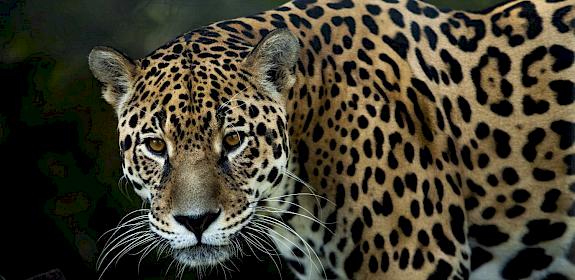Combatting Snow Leopard poaching & trafficking the elusive X factor to conserve Asia’s high mountain ecosystems
Kathmandu, Nepal, 20th January 2017—As scientists and government officials considered new evidence of cross-border migration of Snow Leopard individuals, a presentation of TRAFFIC’s research on poaching and trade emphasised that poachers and traffickers also have no boundaries.
There are possibly as few as 4,000 Snow Leopards surviving in the wild. Contrast that figure with estimates that hundreds of the elusive big cats are being killed illegally each year across their range in Asia’s high mountains and it is clear that the clock is ticking.
TRAFFIC’s synthesis of available information based on seizures and expert opinion was delivered to the Steering Committee of the Global Snow Leopard Ecosystem Protection program (GSLEP) which met in Kathmandu this week.
High-level government representatives from 12 Snow Leopard range countries (Afghanistan, Bhutan, China, India, Kazakhstan, Kyrgyzstan, Mongolia, Nepal, Pakistan, Tajikistan, Russia, Uzbekistan) were informed of the outcomes of a two-day stocktaking workshop on Landscape Management Planning and Mapping. Country presentations had all identified the threat of poaching and illegal trade as a major concern.
TRAFFIC’s report, An Ounce of Prevention: Snow leopard crime revisited (PDF, 3mb) estimates that between 221-450 snow leopards have been poached annually since 2008 – a minimum of four per week. But this number could be substantially higher since many killings in remote areas go undetected.
Combatting poaching and illegal trade of Snow Leopards is a key objective of the GSLEP, which unites all 12 Snow Leopard range countries with intergovernmental and non-governmental organization partners.
“Poaching has been listed as one of the main threats to Snow Leopard populations over at least the last two decades – but little is known about its extent and impact. This report by TRAFFIC is a great step towards building the case for a concerted effort to understand and address the issue”, said Koustubh Sharma, the International Coordinator for the GSLEP secretariat.
TRAFFIC’s analysis provides a blueprint for GSLEP action at national and transboundary levels to protect Snow Leopards from threats posed by poaching and trafficking. Key recommendations to range country governments, communities, conservation experts and donors should be considered as part of an integrated approach to implement the GLSEP objectives
James Compton, Senior Programme Director with TRAFFICUsing a combination of methods, including seizure records, market surveys and expert interviews to provide the first quantitative estimates of the scale of Snow Leopard poaching and trafficking since 2003, the report found that the majority of Snow Leopards are killed in retaliation for attacks on livestock (55%) or by non-targeted methods, such as snares (18%).
Only 21 percent of Snow Leopards were poached specifically for the illegal trade in their pelts and products. However, the report found that over half the retaliatory and non-targeted poaching incidents result in opportunistic attempts to sell, contributing to the estimated 108-219 snow leopards that are illegally traded each year.
“As with Tigers, poaching and trade of Snow Leopards are complex, multi-faceted issues. Understanding these complexities and the factors that influence them is important. It is critical that leadership is provided at the highest level to strongly combat poaching and illegal trade”, said Keshav Varma, Director of the Global Tiger Initiative council.
But in contrast to the trade in Tigers, trade in Snow Leopard products seems to be driven by supply, rather than demand. Thus the major emphasis of interventions should be to prevent poaching, including a focus on retaliation by communities in response to livestock depredation.
The 12 Snow Leopard range countries concurred that a focus on human-wildlife conflict would assist human communities to co-exist with Snow Leopards in Asia’s high mountain landscapes.
“Local communities hold the key to the Snow Leopard’s future. It’s critical that our efforts, such as the recently launched UNDP/GEF project on Transboundary Cooperation for Snow Leopard and Ecosystem Conservation in Central Asia, which the Snow Leopard Trustwill be implementing, focus on the needs of the people who share the cat’s habitat”, said Michael Despines, the Snow Leopard Trust’s Executive Director.
TRAFFIC’s report cites expert evidence that compensation schemes and innovative predator-proof corrals are already making a difference but need to expand these to benefit communities – and Snow Leopards – across Asia’s high mountains. At the same time, the report recommends strengthening both national and transboundary law enforcement, especially as less than a quarter of known cases of Snow Leopard poaching were investigated and just 14 percent were prosecuted.
“The Snow Leopard is a flagship for Asia’s high mountains – a ‘guardian of the headwaters’ of many of the continents watersheds and mighty river systems,” said Rishi Kumar Sharma, WWF Snow Leopard Programme Leader and a co-author of the report. “Conservation efforts that focus on snow leopard habitat will protect whole ecosystems that are key to the sustainable development across a vast expanse of Central and South Asia.”
Notes:
Financial support for the research and publication of TRAFFIC’s report was provided by the WWF Conservation and Adaptation in Asia’s High Mountain Landscapes and Communities Project, funded by the United States Agency for International Development (USAID).





